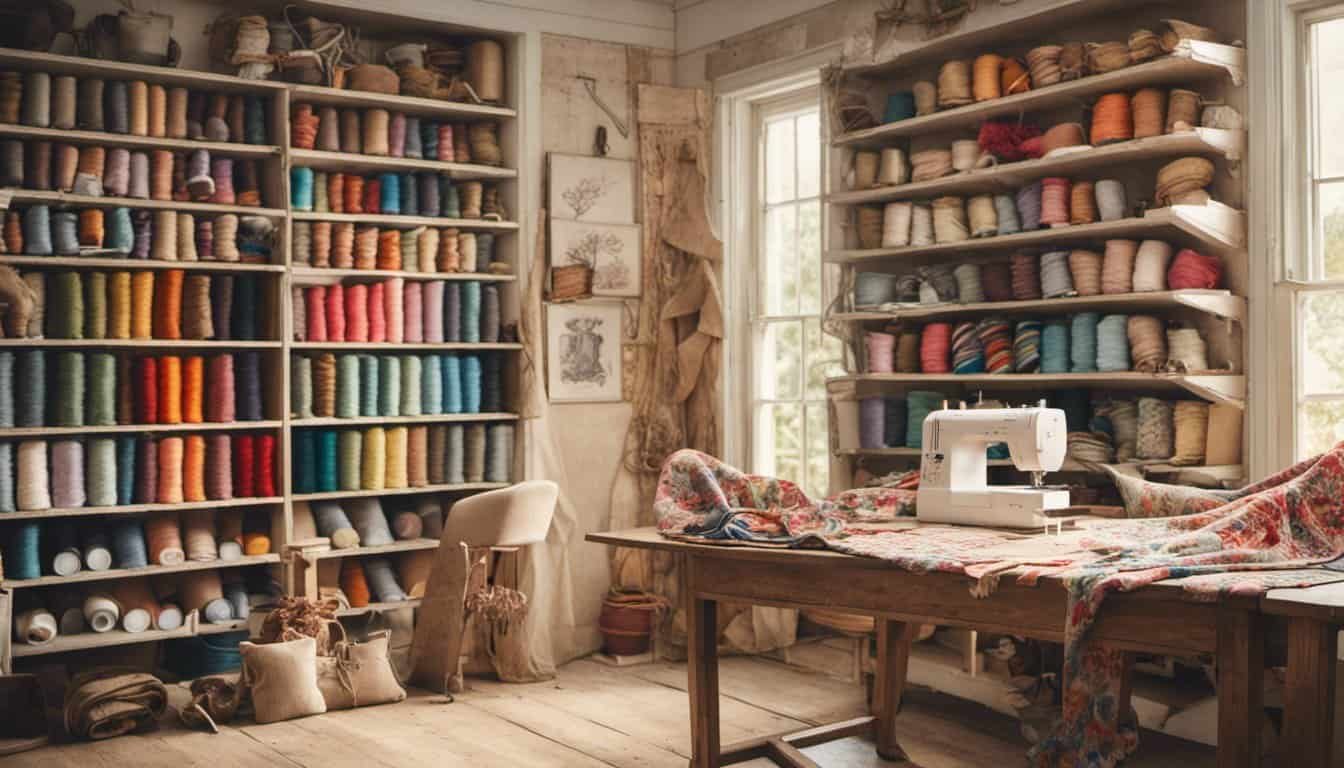If you’re ready to dive into making your own durable bags, canvas is the way to go. It’s strong, flexible, and perfect for creating stylish pieces that stand the test of time.
Working with canvas might seem daunting at first, but once you get the hang of it, you’ll find it a rewarding material. In this guide, you’ll learn the basics and some pro tips to help you craft bags that are both functional and fashionable.
Understanding Canvas for Durable Bags
Canvas is a heavy-duty fabric known for its durability and versatility. Composed typically from cotton or linen, canvas offers the strength needed for long-lasting bags. Its tight weave resists wear and tear, making it suitable for everyday use.
Types of Canvas
Selecting the right canvas involves understanding its various types:
- Cotton Canvas: Natural fibers provide breathability and softness, ideal for casual bags.
- Polyester Canvas: Synthetic fibers offer increased resistance to moisture and UV rays, perfect for outdoor bags.
- Waxed Canvas: Treated with wax enhances water resistance and durability, suitable for rugged applications.
- Blended Canvas: Combines cotton and synthetic fibers, balancing strength and flexibility.
Choosing the Right Weight
Canvas weight determines the fabric’s sturdiness. Refer to the table below for common weights:
| Weight (oz/sq yd) | Description | Best Use |
|---|---|---|
| 8 oz | Lightweight | Stylish, casual |
| 10 oz | Medium weight | Everyday carry |
| 12 oz+ | Heavyweight | Robust, outdoor |
Color and Finish Options
Canvas comes in various colors and finishes:
- Natural: Unbleached canvas retains a raw, organic look.
- Dyed: Available in multiple colors, offering customization.
- Printed: Patterns and designs add aesthetic appeal.
- Coated: Adds water resistance and durability.
Maintenance and Care
Proper care extends your canvas bag’s life:
- Cleaning: Spot clean with mild detergent; avoid harsh chemicals.
- Drying: Air dry to prevent fabric weakening.
- Storage: Keep in a cool, dry place to avoid mold and mildew.
Understanding canvas characteristics enables you to choose the right material for your durable bag projects. Pick the appropriate type, weight, and finish based on your bag’s intended use, ensuring both functionality and longevity.
Selecting the Right Canvas Material
Choosing the right canvas ensures your durable bag meets both style and functionality.
Types of Canvas
Different canvas types offer unique benefits:
- Cotton Canvas: Natural, breathable fibers ideal for everyday use.
- Polyester Canvas: Synthetic, water-resistant properties suitable for outdoor bags.
- Waxed Canvas: Treated with wax, providing extra waterproofing for heavy-duty applications.
- Blended Canvas: Combines cotton and polyester, balancing durability and flexibility.
Choosing the Appropriate Weight
Canvas weight determines your bag’s durability and purpose:
| Canvas Weight | Description | Ideal Use |
|---|---|---|
| 8 oz | Lightweight, flexible | Small accessories |
| 10 oz | Medium weight, balanced strength | Casual totes |
| 12 oz | Heavyweight, highly durable | Backpacks and large bags |
| 14 oz+ | Extra heavy, maximum durability | Industrial or specialized bags |
Select the weight based on your bag’s intended use to ensure longevity and performance.
Tools and Materials Needed
To create durable canvas bags, gather the right tools and materials before starting your project. These essentials ensure quality and efficiency throughout the crafting process.
Essential Sewing Tools
- Heavy-Duty Sewing Machine: Equipped with a strong motor and needle, it handles thick canvas without breaking stitches.
- Sharp Scissors: For precise cutting of canvas and thread.
- Rotary Cutter and Cutting Mat: Facilitates accurate and straight cuts, especially for multiple layers.
- Measuring Tape and Ruler: Ensures accurate dimensions and symmetrical designs.
- Pins and Needle Clips: Keeps fabric pieces aligned during sewing.
- Seam Ripper: Allows quick removal of stitches for adjustments.
- Clipper or Bench Hook: Provides a stable surface for cutting and sewing thick materials.
Additional Supplies
- Canvas Fabric: Choose the appropriate weight (8 oz to 14 oz+) based on your bag’s purpose.
- Thread: Use polyester or nylon thread for strength and durability.
- Interfacing: Reinforces areas like straps and bottoms for added support.
- Hardware: Includes zippers, buckles, D-rings, and snaps for functionality and closure.
- Bias Tape or Webbing: Used for straps and structural elements.
- Embroidery Floss or Fabric Paint: For customizing and adding decorative elements.
- Needles: Use heavy-duty needles compatible with thick fabrics and multiple layers.
- Patterns or Templates: Guides for cutting fabric pieces accurately.
- Fabric Glue or Adhesive Spray: Secures fabric layers before sewing, especially for intricate designs.
| Tool/Material | Purpose |
|---|---|
| Heavy-Duty Sewing Machine | Handles thick canvas and heavy stitching |
| Sharp Scissors | Precise cutting of fabric and thread |
| Rotary Cutter | Accurate, straight cuts for multiple layers |
| Measuring Tape | Ensures accurate dimensions |
| Pins and Needle Clips | Keeps fabric pieces aligned |
| Seam Ripper | Removes stitches for adjustments |
| Interfacing | Reinforces straps and structural areas |
| Hardware | Provides functionality and closures |
Having these tools and materials on hand prepares you to tackle any canvas bag project efficiently. Each item plays a crucial role in ensuring your bags are not only durable but also aesthetically pleasing and functional.

Sewing Techniques for Durability
To ensure your canvas bags stand the test of time, mastering key sewing techniques is essential. Implementing these methods enhances strength and longevity.
Cutting and Preparing the Fabric
Accurate cutting sets the foundation for durable bags. Measure twice and cut once using sharp scissors or a rotary cutter. Pre-wash the canvas to eliminate shrinkage and soften fibers, preventing future distortion. Iron the fabric to remove wrinkles, ensuring precise pattern alignment. Use pattern weights or pins to secure layers, reducing movement during cutting. For complex designs, utilize a cutting mat to maintain consistency across multiple pieces.
Reinforcing Seams
Reinforced seams prevent wear and tear in high-stress areas. Use double stitching or triple stitching along all seams to enhance strength. Select heavy-duty thread, such as polyester or nylon, to withstand regular use. Employ backstitching at the start and end of each seam to secure stitches and reduce fraying. Add interfacing or fabric tape to the inside of seams for extra support without bulk. For corners and stress points, apply flat-felled seams or French seams to distribute tension evenly and maintain a clean finish.
Caring for Your Canvas Bags
Proper maintenance extends the lifespan of your canvas bags. Follow these steps to keep them in excellent condition.
Cleaning Your Canvas Bags
Regular cleaning prevents stains and preserves fabric integrity.
- Spot Cleaning: Use mild detergent and a damp cloth to remove stains.
- Machine Washing: If the bag is machine washable, turn it inside out and wash on a gentle cycle with cold water.
- Drying: Air dry your canvas bag away from direct sunlight to prevent fading and weakening of fibers.
Storing Your Canvas Bags
« Top 10 Best Fabric Scissors for Precise Cutting – Transform Your Sewing Projects
How to Sew Knit Fabrics Without Stretching: 10 Expert Tips You Need »
Proper storage avoids deformation and damage.
- Shape Maintenance: Store bags with their shape supported by stuffing them with tissue paper or using bag trees.
- Environment Control: Keep bags in a cool, dry place to prevent mold and mildew growth.
- Protection: Use dust bags or covers to shield from dust and accidental spills.
Preventing Wear and Tear
Minimize wear to ensure longevity.
- Avoid Overloading: Do not exceed the bag’s weight capacity to prevent seams from stretching or tearing.
- Handle with Care: Use both hands when carrying heavy items to distribute weight evenly.
- Regular Inspection: Check for loose threads or weak spots and reinforce them promptly.
Refreshing Fabric and Hardware
Maintain both fabric appearance and hardware functionality.
- Fabric Refresh: Apply a fabric refresher spray to eliminate odors and keep the canvas looking vibrant.
- Hardware Care: Clean metal hardware with a soft cloth and dry thoroughly to prevent rusting.
Waterproofing Your Canvas Bags
Enhance durability against moisture.
- Waterproof Sprays: Apply a waterproofing spray designed for canvas to repel water and stains.
- Reapplication: Reapply waterproofing treatment every few months or after heavy use to maintain effectiveness.
Handling Stains and Damage
Address issues immediately to prevent permanent damage.

- Stain Removal: Treat stains as soon as they occur using appropriate cleaning agents based on the stain type.
- Repairing Tears: Use a needle and heavy-duty thread to sew small tears. For larger damages, consider professional repair services.
Seasonal Care
Adapt care routines to seasonal changes.
- Winter Care: Protect bags from snow and salt by wiping them down regularly and storing them in a dry place.
- Summer Care: Prevent fading by avoiding prolonged exposure to direct sunlight and keeping bags in shaded areas when not in use.
Long-Term Maintenance
Implement ongoing practices for sustained quality.
- Regular Cleaning Schedule: Establish a routine cleaning schedule based on usage frequency.
- Storage Rotation: Rotate bags in storage to prevent prolonged stress on any single bag.
- Upkeep of Accessories: Inspect and maintain straps, zippers, and other accessories to ensure they remain functional and secure.
By following these care guidelines, your canvas bags will remain durable, functional, and stylish for years to come.
Conclusion
Creating durable canvas bags is not only a practical skill but also a chance to express your personal style. With the right materials and techniques, you can craft bags that last and look great every day. Remember to choose the appropriate canvas weight and color to match your needs and preferences.
Taking care of your bags ensures they remain functional and stylish for years. Regular maintenance and thoughtful design choices make all the difference. So grab your tools and start your canvas bag project today—you’ll find it’s a rewarding way to combine creativity with craftsmanship.


















